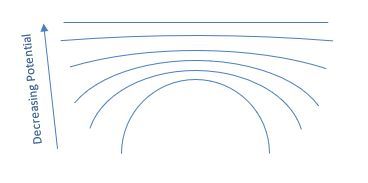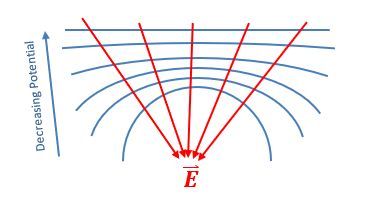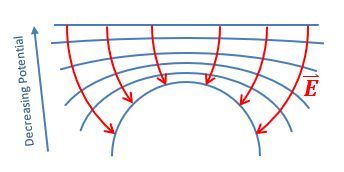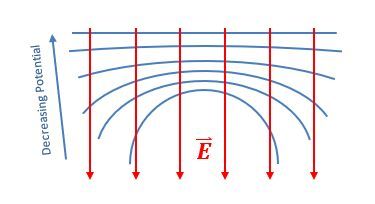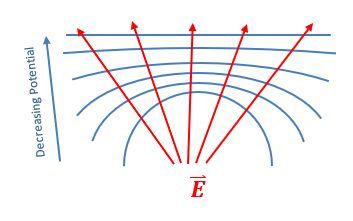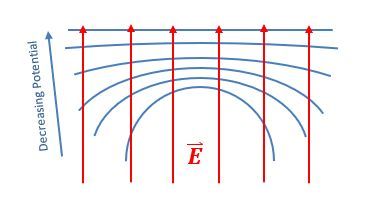Hey, everyone. So by now, we should be pretty familiar with the idea of Electropotentials and potential differences. In this video, we're gonna cover an idea called equipotential surfaces which are really just these boundaries where you have the same potential. We're gonna see how that relates back to things like electric fields and I'm gonna show you a quick example. Alright? So let's get started. So the word equipotential, right, equi just means equal, potential means potential, basically just means that these are surfaces in which you have constant potential. Alright? So what this means here is that along these surfaces, ΔV=0. So what does that mean? So remember that for a point charge, the potential equation is kqr. Alright. So we just have a constant. We have the charge and basically what this means here is the potential is related to the distance away from the point charge. So if I took this point charge here and if I went a distance I'm gonna call this R and if I did that for a bunch of other locations like this and I would always go out the same exact distance r, then I would just end up with a circle of points like this. Mean, I could just connect them all. So if I went anywhere along this circle, I would measure the exact same potential. I'm just gonna go ahead and put a number to this just to make that a little bit simpler. I'm gonna say this is 10 volts. Alright? This is what an equipotential surface is. It's basically just this surface here in which you're gonna have constant potential as you go all the way around. Okay? And so the potential the equipotential surface for point charges just looks like circles. And by the way so there's a couple of things you should know. The one is that, you know, this is the equipotential surface for 10 volts, but there's actually an infinite number of them. Right? So there's another equipotential surface here and this is gonna be for, let's say, this is, 20 volts. Right? There's gonna be another one all the way out here and this is gonna be for 5 volts or something like that. Right? So there's an infinite number of them each corresponding to a very specific number for that potential. Alright? So, before we move on and draw the potential for a dipole, there's a couple of important rules that you need to know. They have to do with the relationship between the electric field and the potential. So just to sort of recap the equation for the electric field you may have seen, this is gonna be -ΔVΔx. What this just means here is that anytime you have a potential difference like you do along these equipotential surfaces here, So here you're gonna have a ΔV. Right? Because your potential is dropping from 20 to 10 to 5. Then you're gonna have an electric field and the electric field points outwards like this. Alright. So another way you could also see this equation written is ΔV=-eΔx. This is just taking this equation over here and rewriting it for ΔV. Now the one thing that's really important you need to know is that this electric field is always going to be perpendicular. So it's always perpendicular to the equipotential surfaces. So notice here how the electric field lines point outwards radially away from the point charge and the equipotential surfaces are circles so that anywhere along you could always basically just draw right angles between the electric field and the equipotential surface. Alright, So that's always going to be true. They're always going to be perpendicular. So what that means is that in some in some questions you might be given some sort of weird equipotential surface like this. So let's say this is your equipotential and you can actually figure out where the electric field is gonna point. We know that it's always gonna be perpendicular so in other words they're gonna be at right angles like this. So th
- 0. Math Review31m
- 1. Intro to Physics Units1h 23m
- 2. 1D Motion / Kinematics3h 56m
- Vectors, Scalars, & Displacement13m
- Average Velocity32m
- Intro to Acceleration7m
- Position-Time Graphs & Velocity26m
- Conceptual Problems with Position-Time Graphs22m
- Velocity-Time Graphs & Acceleration5m
- Calculating Displacement from Velocity-Time Graphs15m
- Conceptual Problems with Velocity-Time Graphs10m
- Calculating Change in Velocity from Acceleration-Time Graphs10m
- Graphing Position, Velocity, and Acceleration Graphs11m
- Kinematics Equations37m
- Vertical Motion and Free Fall19m
- Catch/Overtake Problems23m
- 3. Vectors2h 43m
- Review of Vectors vs. Scalars1m
- Introduction to Vectors7m
- Adding Vectors Graphically22m
- Vector Composition & Decomposition11m
- Adding Vectors by Components13m
- Trig Review24m
- Unit Vectors15m
- Introduction to Dot Product (Scalar Product)12m
- Calculating Dot Product Using Components12m
- Intro to Cross Product (Vector Product)23m
- Calculating Cross Product Using Components17m
- 4. 2D Kinematics1h 42m
- 5. Projectile Motion3h 6m
- 6. Intro to Forces (Dynamics)3h 22m
- 7. Friction, Inclines, Systems2h 44m
- 8. Centripetal Forces & Gravitation7h 26m
- Uniform Circular Motion7m
- Period and Frequency in Uniform Circular Motion20m
- Centripetal Forces15m
- Vertical Centripetal Forces10m
- Flat Curves9m
- Banked Curves10m
- Newton's Law of Gravity30m
- Gravitational Forces in 2D25m
- Acceleration Due to Gravity13m
- Satellite Motion: Intro5m
- Satellite Motion: Speed & Period35m
- Geosynchronous Orbits15m
- Overview of Kepler's Laws5m
- Kepler's First Law11m
- Kepler's Third Law16m
- Kepler's Third Law for Elliptical Orbits15m
- Gravitational Potential Energy21m
- Gravitational Potential Energy for Systems of Masses17m
- Escape Velocity21m
- Energy of Circular Orbits23m
- Energy of Elliptical Orbits36m
- Black Holes16m
- Gravitational Force Inside the Earth13m
- Mass Distribution with Calculus45m
- 9. Work & Energy1h 59m
- 10. Conservation of Energy2h 51m
- Intro to Energy Types3m
- Gravitational Potential Energy10m
- Intro to Conservation of Energy29m
- Energy with Non-Conservative Forces20m
- Springs & Elastic Potential Energy19m
- Solving Projectile Motion Using Energy13m
- Motion Along Curved Paths4m
- Rollercoaster Problems13m
- Pendulum Problems13m
- Energy in Connected Objects (Systems)24m
- Force & Potential Energy18m
- 11. Momentum & Impulse3h 40m
- Intro to Momentum11m
- Intro to Impulse14m
- Impulse with Variable Forces12m
- Intro to Conservation of Momentum17m
- Push-Away Problems19m
- Types of Collisions4m
- Completely Inelastic Collisions28m
- Adding Mass to a Moving System8m
- Collisions & Motion (Momentum & Energy)26m
- Ballistic Pendulum14m
- Collisions with Springs13m
- Elastic Collisions24m
- How to Identify the Type of Collision9m
- Intro to Center of Mass15m
- 12. Rotational Kinematics2h 59m
- 13. Rotational Inertia & Energy7h 4m
- More Conservation of Energy Problems54m
- Conservation of Energy in Rolling Motion45m
- Parallel Axis Theorem13m
- Intro to Moment of Inertia28m
- Moment of Inertia via Integration18m
- Moment of Inertia of Systems23m
- Moment of Inertia & Mass Distribution10m
- Intro to Rotational Kinetic Energy16m
- Energy of Rolling Motion18m
- Types of Motion & Energy24m
- Conservation of Energy with Rotation35m
- Torque with Kinematic Equations56m
- Rotational Dynamics with Two Motions50m
- Rotational Dynamics of Rolling Motion27m
- 14. Torque & Rotational Dynamics2h 5m
- 15. Rotational Equilibrium3h 39m
- 16. Angular Momentum3h 6m
- Opening/Closing Arms on Rotating Stool18m
- Conservation of Angular Momentum46m
- Angular Momentum & Newton's Second Law10m
- Intro to Angular Collisions15m
- Jumping Into/Out of Moving Disc23m
- Spinning on String of Variable Length20m
- Angular Collisions with Linear Motion8m
- Intro to Angular Momentum15m
- Angular Momentum of a Point Mass21m
- Angular Momentum of Objects in Linear Motion7m
- 17. Periodic Motion2h 9m
- 18. Waves & Sound3h 40m
- Intro to Waves11m
- Velocity of Transverse Waves21m
- Velocity of Longitudinal Waves11m
- Wave Functions31m
- Phase Constant14m
- Average Power of Waves on Strings10m
- Wave Intensity19m
- Sound Intensity13m
- Wave Interference8m
- Superposition of Wave Functions3m
- Standing Waves30m
- Standing Wave Functions14m
- Standing Sound Waves12m
- Beats8m
- The Doppler Effect7m
- 19. Fluid Mechanics2h 27m
- 20. Heat and Temperature3h 7m
- Temperature16m
- Linear Thermal Expansion14m
- Volume Thermal Expansion14m
- Moles and Avogadro's Number14m
- Specific Heat & Temperature Changes12m
- Latent Heat & Phase Changes16m
- Intro to Calorimetry21m
- Calorimetry with Temperature and Phase Changes15m
- Advanced Calorimetry: Equilibrium Temperature with Phase Changes9m
- Phase Diagrams, Triple Points and Critical Points6m
- Heat Transfer44m
- 21. Kinetic Theory of Ideal Gases1h 50m
- 22. The First Law of Thermodynamics1h 26m
- 23. The Second Law of Thermodynamics3h 11m
- 24. Electric Force & Field; Gauss' Law3h 42m
- 25. Electric Potential1h 51m
- 26. Capacitors & Dielectrics2h 2m
- 27. Resistors & DC Circuits3h 8m
- 28. Magnetic Fields and Forces2h 23m
- 29. Sources of Magnetic Field2h 30m
- Magnetic Field Produced by Moving Charges10m
- Magnetic Field Produced by Straight Currents27m
- Magnetic Force Between Parallel Currents12m
- Magnetic Force Between Two Moving Charges9m
- Magnetic Field Produced by Loops and Solenoids42m
- Toroidal Solenoids aka Toroids12m
- Biot-Savart Law (Calculus)18m
- Ampere's Law (Calculus)17m
- 30. Induction and Inductance3h 37m
- 31. Alternating Current2h 37m
- Alternating Voltages and Currents18m
- RMS Current and Voltage9m
- Phasors20m
- Resistors in AC Circuits9m
- Phasors for Resistors7m
- Capacitors in AC Circuits16m
- Phasors for Capacitors8m
- Inductors in AC Circuits13m
- Phasors for Inductors7m
- Impedance in AC Circuits18m
- Series LRC Circuits11m
- Resonance in Series LRC Circuits10m
- Power in AC Circuits5m
- 32. Electromagnetic Waves2h 14m
- 33. Geometric Optics2h 57m
- 34. Wave Optics1h 15m
- 35. Special Relativity2h 10m
Equipotential Surfaces - Online Tutor, Practice Problems & Exam Prep
 Created using AI
Created using AIEquipotential surfaces are regions where electric potential remains constant, meaning that the potential difference (ΔV) is zero. For a point charge, these surfaces appear as concentric circles. The electric field (E) is always perpendicular to these surfaces and points in the direction of decreasing potential. For electric dipoles, equipotential surfaces take on a more complex shape, often resembling straight lines near the center. The work done in moving a charge along an equipotential surface is zero, while moving between different surfaces requires work against the electric field. The equation for electric potential is given by V = kqr.
Equipotential Surfaces
Video transcript
Field due to Equipotential Surfaces
Video transcript
What's up, folks? Let's work out this example problem with equipotential surfaces. So we've got these equipotential surfaces, and we're told what the potentials of each of those surfaces are, and we're also given what the spacing between them is. And using that information, we're supposed to figure out what the magnitude and the direction of the electric field due to those equipotential surfaces. Remember that there are two rules that we need to remember: the field lines are perpendicular to the equipotentials, which means that we know the electric field is going to point along this direction. But they also point in decreasing potentials. They point along decreasing potentials. So that means that the electric field has to point in this direction, which actually takes care of the second part of our problem. What is the direction of the electric field? And in more precise terms, if we know that the electric field is going to point in this, we could say is that if this angle makes a 60-degree angle with the x-axis, then that means our electric field is actually going to be pointing We're going to need to know this angle right here. So this is 30 degrees because these two things are supposed to be perpendicular. So in other words, as for the direction, the electric field will point 30 degrees below the negative x-axis. And that is the answer as for the direction.
So how do we calculate the magnitude? How do we calculate what the electric field is due to potential surfaces or changing potentials? We use the equation E = - ΔVΔx. Since we already took care of the direction, we'll focus on the magnitude. We already know that between each successive sector here or each little specific segment, we're changing 5 volts and we're doing that across the spacing of 1 centimeter, which converts to 0.01 meters. So that means that the electric field is going to have a constant magnitude of 500 volts per meter. By the way, if you're not familiar with this volts per meter unit, this actually also turns into newtons per coulomb. It's a different way to sort of express that.
So that's how you figure out what the magnitude and the direction of the electric field are due to equipotentials. First, figure out what the potential differences are, the spacings, and then just figure out your direction by going towards decreasing potentials and perpendicular to those equipotential surfaces. Alright? Let me know if you guys have any questions.
Draw the electric field that corresponds to the equipotential surfaces shown in the following figure. Note that the potential is decreasing in the upward direction.
Do you want more practice?
More setsHere’s what students ask on this topic:
What are equipotential surfaces in physics?
Equipotential surfaces are regions in space where the electric potential is constant. This means that the potential difference (ΔV) between any two points on the surface is zero. For a point charge, these surfaces appear as concentric circles centered around the charge. The electric field (E) is always perpendicular to these surfaces and points in the direction of decreasing potential. Equipotential surfaces are useful in visualizing electric fields and understanding the work done in moving charges within an electric field.
 Created using AI
Created using AIHow do equipotential surfaces relate to electric fields?
Equipotential surfaces are always perpendicular to electric field lines. The electric field (E) points in the direction of decreasing potential, meaning it is perpendicular to the equipotential surfaces. This relationship can be expressed by the equation . This perpendicularity helps in visualizing the direction and strength of the electric field. Additionally, no work is required to move a charge along an equipotential surface, as ΔV is zero.
 Created using AI
Created using AIWhat is the significance of equipotential surfaces in electric dipoles?
In electric dipoles, equipotential surfaces take on more complex shapes compared to point charges. Near the center of a dipole, these surfaces often resemble straight vertical lines. This is because the electric potential from the positive and negative charges cancels out along these lines. As you move closer to one of the charges, the equipotential surfaces become more curved. Understanding these surfaces helps in visualizing the electric field and potential distribution around dipoles, which is crucial for solving problems involving dipole interactions.
 Created using AI
Created using AIWhy is no work required to move a charge along an equipotential surface?
No work is required to move a charge along an equipotential surface because the potential difference (ΔV) along the surface is zero. The work done (W) in moving a charge (q) is given by the equation . Since ΔV is zero on an equipotential surface, the work done is also zero. This property simplifies calculations and helps in understanding the behavior of charges in electric fields.
 Created using AI
Created using AIHow do you calculate the distance to an equipotential surface for a point charge?
To calculate the distance (r) to an equipotential surface for a point charge, you can use the equation for electric potential . Rearrange this equation to solve for r: . For example, if you have a 1 μC point charge and want to find the distance to an equipotential surface of 150 V, you would calculate .
 Created using AI
Created using AIYour Physics tutor
- A very large plastic sheet carries a uniform charge density of -6.00 nC/m^2 on one face. (a) As you move away ...
- CALC. A metal sphere with radius r_a is supported on an insulating stand at the center of a hollow, metal, sph...
- CALC. A metal sphere with radius r_a is supported on an insulating stand at the center of a hollow, metal, sph...
- CALC. A metal sphere with radius r_a is supported on an insulating stand at the center of a hollow, metal, sph...
- CALC. A metal sphere with radius r_a is supported on an insulating stand at the center of a hollow, metal, sph...
- CALC. A metal sphere with radius r_a is supported on an insulating stand at the center of a hollow, metal, sph...
- A −2.0 V equipotential surface and a +2.0 V equipotential surface are 1.0 mm apart. What is the electric field...
- (II) A metal sphere of radius r₀ = 0.35 m carries a charge Q = 0.50 μC. Equipotential surfaces are to be drawn...
- (I) Draw a conductor in the oblong shape of a football. This conductor carries a net negative charge, -Q. Sket...
